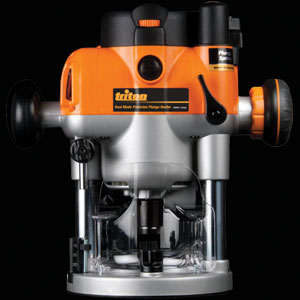
Here’s the best router yet for mounting in a table. And it’s fitting. The new Triton router is from the Land Down Under. (Australia, mate. Remember?)
This 3 1/4 hp, 15 amp, variable-speed tool looks to me like a war machine from Star Wars, what with its squat motor and compact knobs perched high on beefy posts.
Sliding it around atop a workpiece reinforces that image, since the extremely high knob placement makes it pretty ungainly.
But the Triton has two revolutionary features for table-mounting: a winder-operated, rack-and-pinion, micro-adjustable system for setting the depth-of-cut and one-wrench, above-the-table bit changing.
I’ved used the Triton for only a couple of weeks, but already I can tell it’s going to be my router-table warrior.
The Triton has two modes: plunge and “winder.” Turn the mode selector in the hand-grip to “unlock” and the router operates like a typical plunge router, complete with a plunge-lock lever beside one of the handgrips and a two-position depth-stop turret. But turn the selector to “lock,” and that hand-grip becomes a “winder.” Squeeze the winder’s lock-ring and turn it to raise and lower the motor on the posts.
Release the lock-ring to hold the elevation. A separate micro-adjust knob raises or lowers the bit in those superfine increments-1/32ths, 1/128ths, thousandths, micromillimeters. What’s your measuring pleasure?
More Good Stuff!
Wind the motor as far as it will go into the base. The collet projects a good 3/4″ beyond the router’s base. At the same time, a spindle lock automatically engages and a cover over the power switch locks. The collet is above the table now, and only one wrench is needed to loosen it. Just a quarter-turn frees the bit. Because the switch cover is locked, you can’t turn on the router, even if you tried (I did, I did. It won’t power up.) And if the switch is on, the router cannot be plunged to bit-changing depth. (Yeah, I tried that too, and that feature works as well.)
Because of the through-the-base bit-changing arrangement, clear polycarbonate shields between the base and motor provide chip defection and collection.







